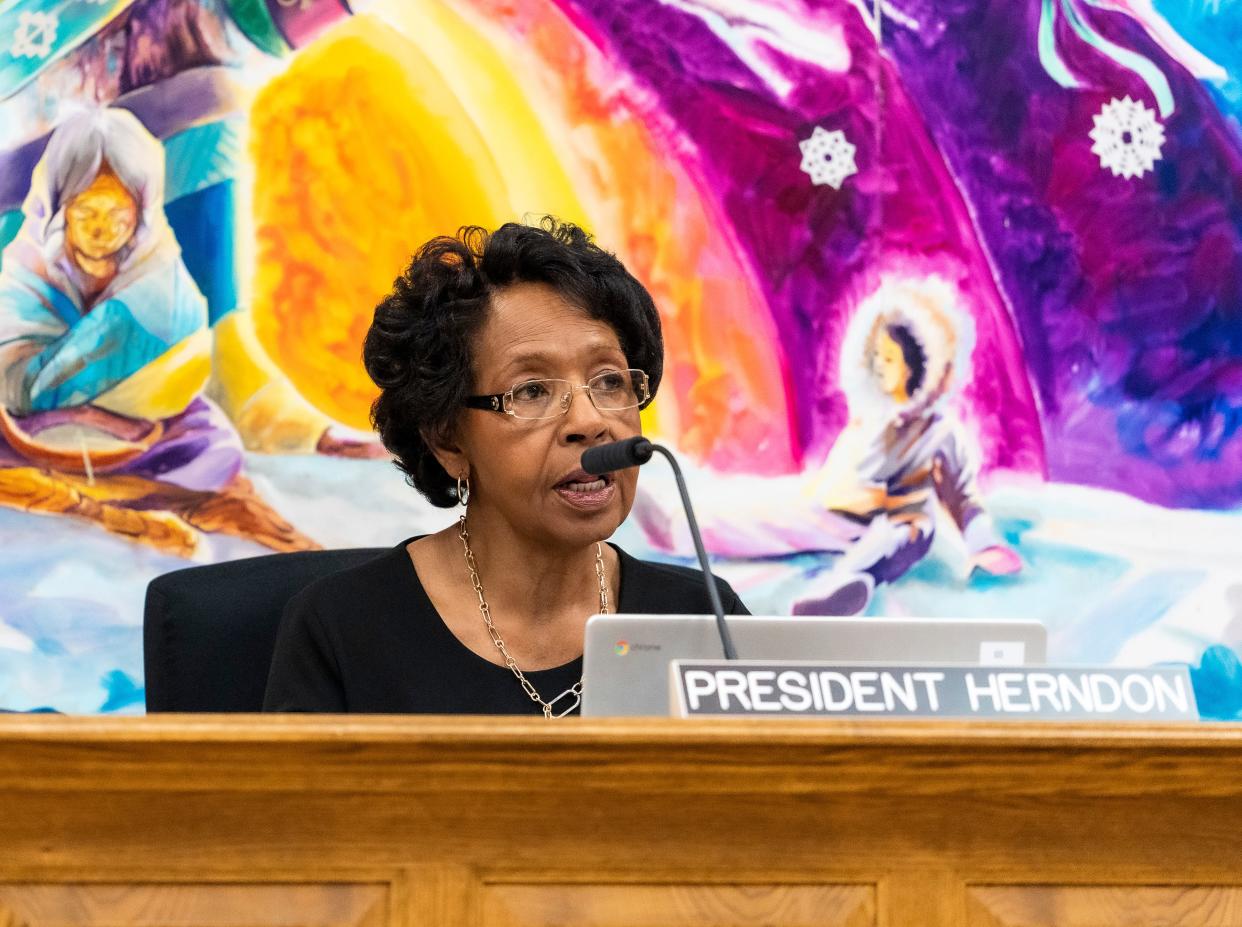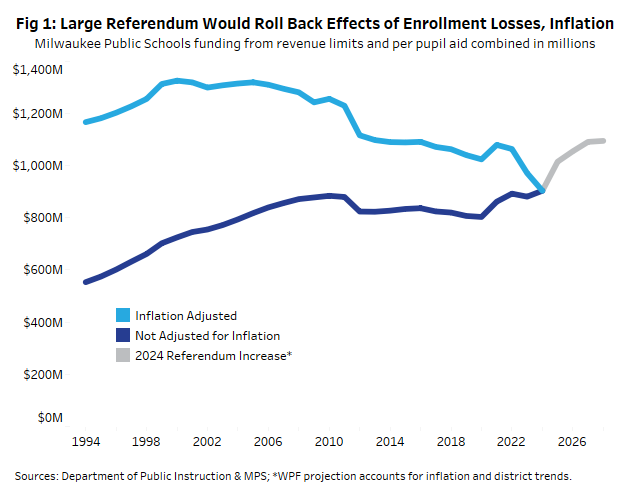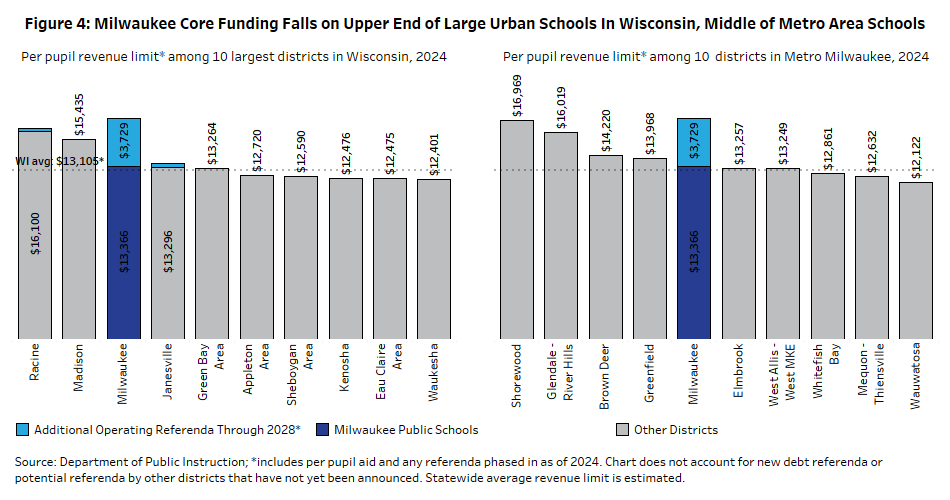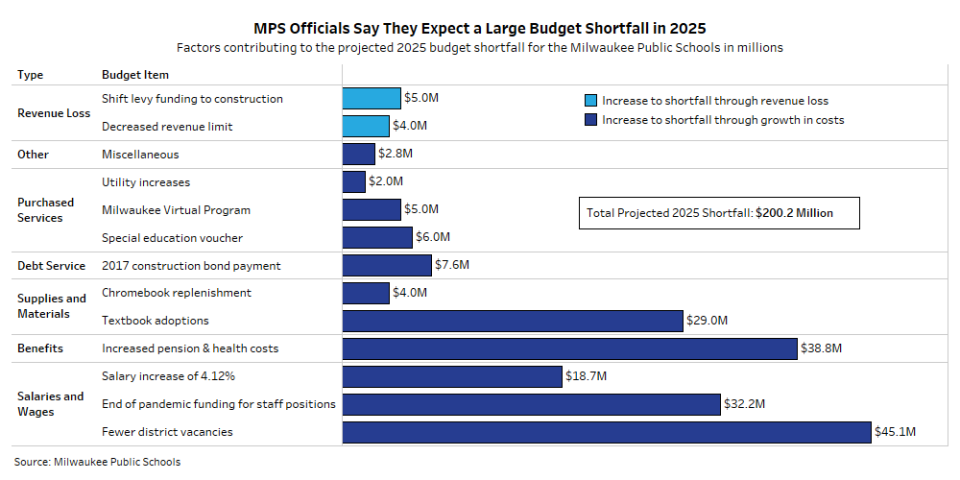Should voters support April 2 referendum for MPS? Policy Forum breaks it down.

At the polls April 2, Milwaukee voters will be asked to raise their property taxes to increase funding for Milwaukee Public Schools.
Milwaukee isn't alone facing this question. About 100 other school districts — nearly a quarter of the state's districts — are asking their local voters for more money this year as state funding has fallen behind inflation.
Milwaukee Public Schools leaders say they face a $200 million budget shortfall for the next school year if voters don't approve the referendum. If approved by voters, MPS would be allowed to increase revenue by up to $140 million in the first year, with the amount growing up to $252 million in four years.
If approved, the city property tax rate rate for schools would rise by an estimated $2.16 per $1,000 of property value, to a total of $10.10 per $1,000 of property value. For a $200,000 home, that would be an increase of $432, increasing the schools tax from $1,588 to $2,020.
A few weeks ahead of the vote, a report from the Wisconsin Policy Forum examines the district's case for a referendum. The forum is a nonpartisan, independent policy research organization. Here's what the group found.
What's going on with MPS funding?
When you adjust for inflation, there's no question that MPS gets less core state and local funding than it used to.
School districts across Wisconsin are strained because state-imposed revenue limits on the primary sources of school funding haven't lifted enough to keep pace with inflation over the last 15 years. If that funding had kept up with inflation, MPS officials estimate the district would be getting an extra $210 million each year.
At the same time, the biggest reason funding for MPS has dropped, the report says, is that MPS doesn't have as many students as it used to. That's partly because there are fewer children in the city, and partly because of the growth of non-MPS schools, like independent charter schools and private schools that get tax-funded vouchers. When students leave MPS, the funding goes with them.
Without a successful referendum, MPS Chief Financial Officer Martha Kreitzman said, the district could have to cut staff, freeze salaries, close schools, eliminate specialty programs, reduce mental health supports, reduce transportation, delay building repairs, or delay updates for educational materials and technology.

So the district has less funding overall. But what about on a per-student basis?
Thanks to a previous referendum in 2020, when Milwaukeeans agreed to raise taxes for MPS, the district got about $13,366 per student this year in core funding, including funding under its revenue limit and state categorical aid. That's slightly above the inflation-adjusted amount it got in 2004, about $13,319 per student, the Forum found.
That doesn't necessarily leave the district in a financially secure place. Nicole Armendariz, communications director for MPS, said the district has had to use its core funding to pay for a larger portion of costs for special services that used to be covered more by separate federal and state funds, including those for students with disabilities, English language learners and students in poverty.
"The constant depletion of these resources creates a significant economic challenge," Armendariz said in an email.
How does MPS funding compare to other districts?
Funding levels vary between Wisconsin school districts because state lawmakers in 1993 imposed caps on how much tax revenue districts could collect. School districts were locked in at whatever they happened to collect the previous year. The only way for districts to get around those caps is to go to their local voters with a referendum, which most have done at least once.
Compared to districts in the metro area, MPS' revenue limit is lower than Shorewood, Glendale-River Hills, Brown Deer and Greenfield, according to the report. It is higher than Elmbrook, West Allis-West Milwaukee, Whitefish Bay, Mequon-Thiensville and Wauwatosa.
Compared to other large districts, MPS' revenue limit is lower than Racine and Madison but higher than Green Bay, Kenosha, Waukesha and others.

The Forum notes that compared to most districts, MPS serves higher percentages of students from lower-income families, students with disabilities and English language learners. There are higher costs for educating students with more needs — some, but not all, of which are covered by other state and federal aids for these populations. State funding for special education, for example, only covers about a third of the cost.
Has MPS done enough to cut costs?
Those opposing the referendum — including the Milwaukee Metropolitan Chamber of Commerce and a new political action committee launched by Milwaukee attorney Dan Adams — have argued that MPS hasn't done enough to reduce costs proportionately to its declining enrollment.
The number of students in MPS has dropped by about 32% since 2004, the Forum reported, with an enrollment count of 67,577 this year.
According to the Forum's report, MPS peaked with 178 buildings in 2008 and had downsized to 150 as of 2022. The district is in the process of updating its long-range facilities plan. The Forum called that process "a welcome move but arguably one that should have occurred before the upcoming referendum so that any savings yielded could be factored into the district’s fiscal forecast."
The district appears to have made more significant reductions in staffing. The Forum pointed to district financial reports that show the number of MPS instructional staff dropped by about 37% between 2004 and 2022, the most recent year available. That includes teachers, principals, counselors, librarians and supervisors.
How did MPS calculate a $200 million deficit?
Key to the referendum request is a projection from MPS that it faces a $200 million budget hole. The referendum, if approved, will fill most of that hole. Critics say the district has not revealed a detailed enough explanation of that deficit or a plan for where the referendum funds would go.
The largest chunk of the projected budget shortfall, about $45 million of it, comes from the assumption that MPS will fill most of its vacant positions, the Forum found.
Massive vacancies in recent years have saved the district money in previous budgets. MPS balanced its budget for this school year by banking on hundreds of positions going unfilled. As of February, the Forum received data from MPS showing 639 vacant positions, including 292 teacher vacancies.
The Forum posited that if the district were to cut vacant positions from its budget, it would face a lesser deficit. MPS leaders have argued that those positions need to be filled. Many of the vacant positions are in areas the district promised to grow: art, music, physical education, early childhood and support staff.
"The best way to serve our children and help prepare them for college and career is to ensure they have teachers and support staff in front of them every day," Armendariz said in an email, adding that the district has had recent success recruiting more staff, including the hiring of 150 international teachers.
Another chunk of the projected shortfall, about $32 million, comes from the loss of pandemic-relief dollars that were used to fund staff positions, the Forum reported. About half of this chunk specifically supports art, music, health and physical education teachers.
Additionally, the district projects about $39 million in increased pension and health costs. It also assumes a 4.12% cost-of-living wage increase for all staff, which adds about another $19 million.
Other projected shortfalls include $33 million for textbooks and Chromebooks, $8 million for construction debt and $13 million for purchased services.

How much will taxes go up?
If approved by voters, MPS would be allowed to increase revenue by up to $140 million in the 2024-25 school year. The amount would rise over each of the following school years by up to an additional $51 million, then $47 million, and finally another $14 million in the 2027-28 school year.
The amount would stop rising after the 2027-28 school year, topping out at up to $252 million. The district could continue receiving that amount each year thereafter.
Those amounts won't fully fall on local property taxes, as state funding is expected to cover most of the burden of the referendum after the first year. MPS estimates the local property tax levy will rise by about $97 million the first year, and then by $10 million in each of the subsequent three years.
What does that mean for an individual taxpayer?
According to MPS, additional taxes from the referendum would level out after the first year, when they would increase by about $2.16 per $1,000 of property value, a $432 increase for a $200,000 property.
That estimate is built on several factors.
First, the Forum explains that the first-year projection is lower than it otherwise would be because of the district's plan to reduce another piece of the school tax — a levy used to fund community service projects — by about $80 million. The district had inflated that fund temporarily for the current school year in part to collect funds for a new community center at the former Browning School.
The Forum also examined the claim that the referendum wouldn't cause further tax increases after the first year. MPS has said that because state funding is based on how much a school district collected in the prior year, the referendum will trigger more state funding in future years. It also considers that enrollment will likely continue declining, which reduces how much the district can collect.
The Forum found these expectations to be "reasonable," noting that the same factors played out with the 2020 referendum and the "same dynamic would be in play this time," though there are unknown factors, such as state budgeting decisions and changes to city property values.
Contact Rory Linnane at [email protected]. Follow her on X (Twitter) at @RoryLinnane.
This article originally appeared on Milwaukee Journal Sentinel: Policy Forum report: does MPS need April 2 Milwaukee referendum?
